The Gilded Age’s Stunning Wedding Gown: A Historical and Fashionable Masterpiece
The wedding gown worn by Gladys Russell in the hit series The Gilded Age is a stunning example of historical inspiration and meticulous craftsmanship. Designed with input from a global team of artisans, the dress pays homage to a real-life socialite who shares striking similarities with another iconic figure—Princess Diana.
A Glimpse into the Past
The Gilded Age, created by Julian Fellowes, has often been criticized for its slow pacing, focusing on intricate social dynamics rather than dramatic plot twists. However, for fans of period dramas, the show offers rich storytelling filled with class commentary, opulent settings, and unforgettable fashion moments. The third season, which premiered on June 22, elevates the drama even further, making it a must-watch this summer.
The storyline centers around Gladys Russell (Taissa Farmiga), a railroad heiress whose mother, Bertha Russell (Carrie Coon), is determined to elevate their family’s status through a marriage to a British duke. This dynamic sets the stage for one of the most anticipated episodes of the season, “Marriage Is a Gamble,” where Gladys reluctantly agrees to marry the Duke of Buckingham.
The Wedding That Captivated Everyone
Gladys’s wedding day is a visual spectacle, marked by an elaborate long-sleeved gown adorned with rosettes and a cascading train. The dress, inspired by historical references, adds to the tragic tone of her reluctant union. Alongside the bride, the entire cast was dressed in historically accurate attire, including the bridesmaids and clergy, all contributing to the opulence of the scene.
The Artisans Behind the Glamour
Costume designer Kasia Walicka-Maimone played a crucial role in bringing this vision to life. She collaborated with a diverse group of artisans across the globe to create the perfect wedding ensemble. The fabric for the gown was sourced from New York City’s garment district, while the flower embellishments were hand-attached. The dress itself was crafted in Italy by Tirelli Costumi, and the veil was made from English lace by milliners Camilla Chuvarsky and Rhyan Shipman.
Once the dress arrived from Italy, the show’s in-house tailors, led by Sue Bakula, added the final touches. Jewelry, sourced from Italy, completed the look, creating a romantic and luxurious appearance befitting a leading heiress.
A Real-Life Inspiration
The design of Gladys’s gown was directly influenced by a real-life socialite—Consuelo Vanderbilt. Her wedding to the Duke of Marlborough served as a key reference point for the show. “We used it as a source of inspiration for certain elements, like our bridesmaid dresses and the length of Gladys’s train,” Walicka-Maimone explains. “The overall feel of the wedding and the wedding dress being a day dress were directly inspired by Consuelo’s wedding.”
Consuelo’s story mirrors that of Gladys in many ways. Like Bertha Russell, Alma Vanderbilt arranged a loveless marriage for her daughter, leading to a life of privilege but deep unhappiness. Consuelo became a prominent figure in European society, influencing style and culture during the 19th century.
A Connection to Princess Diana
Interestingly, historians often draw parallels between Consuelo and Princess Diana. Both wore gowns with long sleeves, lace trim, frills, and cascading trains on their wedding days. Their shared family name and tragic love lives have led many to consider Consuelo as the Princess Diana of her time.
This connection makes The Gilded Age feel reminiscent of The Crown, blending historical accuracy with dramatic storytelling. For fans of both shows, the similarities are hard to ignore.
Conclusion
The wedding gown in The Gilded Age is more than just a piece of clothing—it’s a symbol of history, influence, and artistic collaboration. Through the efforts of a global team of artisans, the show brings to life a moment that resonates with both the past and present. Whether you’re a fan of period dramas or simply appreciate beautiful fashion, the attention to detail in this episode is truly remarkable.







